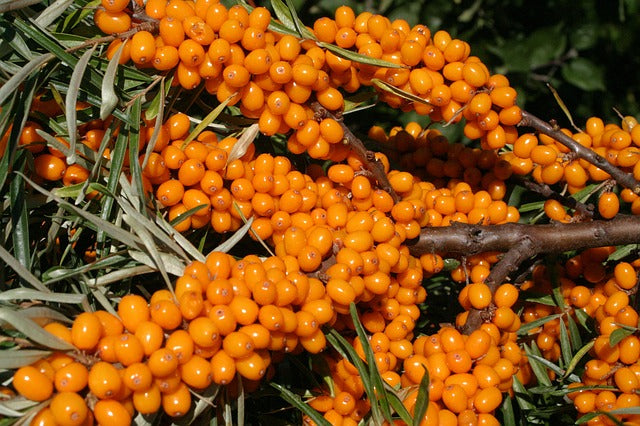Despite its name, Sea Buckthorn grows in many other places than by the shore.
Common Sea Buckthorn is a native plant throughout northern Europe and Asia. Its range extends from the Atlantic coast to northern Mongolia and China.

In Europe, it is found on sea coasts or in mountainous areas while in central asia, it is often found in arid and semi arid deserts. On the coasts, Sea Buckthorn can thrive in places where the salty sea air discourages most other plants from growing. It is often planted next to rivers and streams where its deep root systems prevent erosion. Paradoxically, in deserts, the Sea Buckthorn is planted to prevent the desert from increasing in size.
For thousands of years, the fruit, seeds and leaves of the plant have been used as medicine to treat various ailments. The berries, leaves and seeds have also been used as a traditional food. The flowers and leaves are dried and ground to make tea, while the bright orange berries have such a high concentration of vitamins and minerals that they are still used to make juice, jelly, and sauces. Due to the high demand, many countries have begun cultivating it commercially.
Sea Buckthorn has been used traditionally to heal wounds and hydrate skin. The berries and seeds have been pressed to extract their oil which has been used on the skin for centuries. Science confirms that Sea Buckthorn has so many healing properties it qualifies as a wonder ingredient for skin.

Vitamin Rich
Sea Buckthorn is rich in Vitamins B1, B2, K, A, and has levels of vitamin C that are ten times the amount found in lemons or oranges. Sea Buckthorn is the third highest plant source of vitamin E. It’s a smoothie for your skin!
The combination of naturally occuring Vitamin C with Vitamin E creates an anti-inflammatory and antioxidant powerhouse. An antioxidant reduces the ability of free radicals to damage the cells. Traditionally Sea Buckthorn oil has been rubbed on the skin after sun exposure and has a calming effect on the skin. It is being studied to see if it indeed reduces skin damage.

Sea Buckthorn’s ability to reduce inflammation can have positive effects on acne. The anti-inflammatory properties help to calm the skin from the inside and promote healing on a cellular level.
Sea Buckthorn oil contains several lipids and fatty acids. I know what you’re thinking hearing about the presence of fatty acids in a skincare ingredient. In order to be healthy, the skin and body need healthy fats. The linolic acid in Sea Buckthorn matches the linolic acid the skin and body produce. This fatty acid can help the skin or hair to regulate the sebum (oil) it produces which creates more balanced and less oily skin.
An article from 2017 details the many ways that Sea Buckthorn oil can improve skin cell regeneration. The oil prevents moisture from escaping the cells which keeps the cells hydrated. On the cellular level when skin cells are well hydrated, the appearance of wrinkles can decrease.
Our Top Choices
Our Rose & Sea Buckthorn Cream Cleanser is a gentle way to cleanse your skin. The organic extracts combine to keep your skin hydrated and supple.
In the Frankincense & Rose Geranium Oil Serum the beneficial fatty acids of Sea Buckthorn meld with other antioxidants to create a light but deeply nourishing treatment. The presence of Sea Buckthorn increases the balancing power of this serum!
Welcome Sea Buckthorn into your skincare routine. We’d love to hear how your skin drinks it up!



Where do I buy the oil
Leave a comment